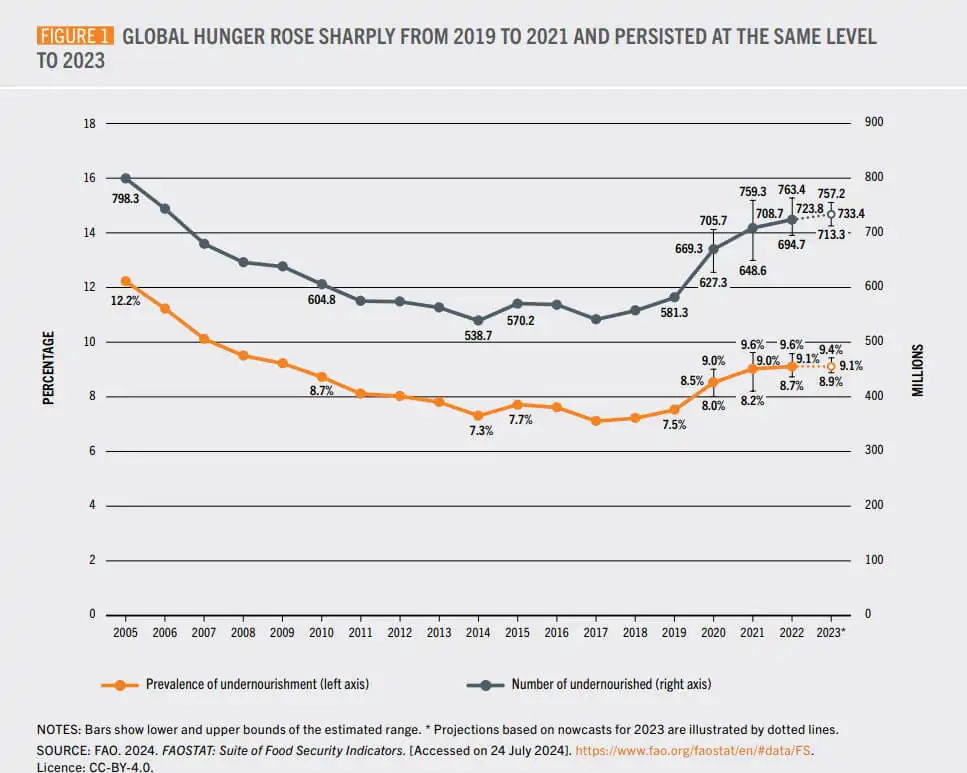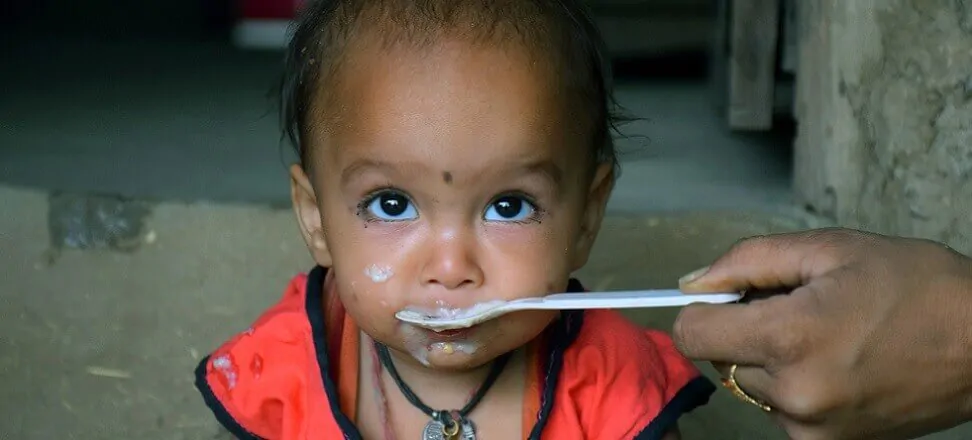Business and economics, Issue 15/2024
The catastrophic state of food security, or why the world is starving
In 2023. One in 11 people on Earth has experienced hunger, according to the just-released report entitled The State of Food Security and Nutrition in the World. This shocking statistic takes on an even more frightening dimension when one realizes that 43 percent of the global population is overweight or obese, and one-fifth of all food is wasted. International experts wonder what can be done to solve this paradox and why the current food aid system is so deeply flawed.
About the report The State of Food Security and Nutrition in the World
This report is the result of cooperation between the Food and Agriculture Organization of the United Nations (FAO), the International Fund for Agricultural Development (IFAD), the World Food Program (WFP), the World Health Organization (WHO) and the United Nations Children’s Fund (UNICEF). The publication is cyclical and comes out every year – unfortunately, so far its conclusions are more alarming each time.
The main conclusion of this year’s report is that changes are needed in the way the fight against hunger is financed, which currently focuses on providing people with food rather than addressing the causes of malnutrition. The latter include, in particular, climate variability and weather anomalies, global conflicts and economic crises. These factors exacerbate long-standing problems, such as social inequality and lack of access to healthy food. Public and private funds must begin to act in a coordinated manner where their impact will be greatest, the report’s authors argue, reminding us of the lofty goal of Zero Hunger in 2030, the realization of which seems unrealistic today.
Food security in numbers – black statistics
The number of hungry people in the world rose sharply in 2019-2021 due to the Covid-19 pandemic, before stabilizing at today’s levels. In 2023. 9.1 percent of the global population suffered from malnutrition. The problem is most acute in Africa, where hunger is experienced by 20.4 percent of the population and the rate is steadily rising. In Asia, the figure is “only” 8.1 percent, but on a per-citizen basis it is as high as 384.5 million. According to forecasts, in 2030 there are expected to be 532 million chronically undernourished people in the world, and 53 percent of all hungry people will live in Africa.
Hunger is an extreme situation, but it should not be forgotten that inadequate food security is a problem in many regions of the world. In 2023. As many as 2.3 billion people (28.9 percent of the global population) lacked consistent access to adequate food. Of these, 864 million experienced severe shortages and spent at least one day without food. Closer analysis shows that food insecurity primarily affects rural areas (a rate of 31.9 percent) and more often women than men.

The cost of healthy nutrition and the consequences of deficiencies
For a more complete economic analysis of the problem of hunger, the Cost of Healthy Diet (CoHD) index was adopted, which defines the cost of purchasing the cheapest possible menu that covers nutritional needs in a given country. We are talking about locally available products, the consumption of which will meet the energy and nutritional needs of the body. The index is compared with the incomes of different population groups to see where acquiring an adequate amount of healthy food is most difficult.
According to the report, CoHD has been growing steadily since 2017. and in 2022. It reached a peak of $3.96. Purchasing Power Parity (PPP) per person per day. It was highest in South America and the Caribbean ($4.56 PPP), while in Asia it was $4.20. PPP, and in Africa it was $3.74. PPP. This means that as many as 2.83 billion people cannot afford to buy healthy food. In recent years, the situation has improved somewhat in Asia, North America and Europe, but worsened in Africa.
Food insecurity is clearly taking a toll on the health of populations. Low birth weight is still recorded in almost 15 percent. of newborns, indicating a lack of any improvement over the past decade. To almost 30 percent. The incidence of anemia in women of childbearing age has also increased. In contrast, the rate of developmental delays in children under five has improved, but is still as high as 22.3 percent. globally. Extreme emaciation remains at 6.8 percent. of young children.
Financing food security
The report’s authors note the need to better define and quantify global financial assistance related to the fight against hunger. The funding is intended to strengthen the agricultural sector in the face of key factors undermining food security, including climate change, which particularly affects low- and moderate-income countries. It should include not only relatively easy-to-measure public support, but also more difficult-to-count private financing.
The structure of financial aid is also key. Of the $77 billion. officially spent in 2021. on food security and nutrition, $35 billion. was directed directly to buying food for the needy. Only $27 billion. was allocated to combating the causes of malnutrition, and only $15 billion. for health support. This is clearly not enough. The report’s authors point out that, according to various scientific studies, it would take an additional 176 billion to achieve Sustainable Development Goals 2.1 and 2.2 (eliminating hunger and all forms of malnutrition by 2030), and ideally we should be able to allocate close to $4 trillion.
Intervention is cheaper than passivity
The fight for global food security is definitely not cheap. However, as part of the economic calculus, it is necessary to consider a scenario in which additional funds for eliminating hunger are not raised. The medium- and long-term social and health consequences of inaction will be catastrophic. The costs associated with mortality and disease resulting from current levels of nutrition by 2030. are expected to reach $1.3 million. At an additional $10 trillion. is estimated to be the hidden costs associated with lost agricultural productivity due to increased disease risk. According to analysts, the redirection of global aid funds toward the agriculture and food sector will make the cost of a healthy diet decrease and its availability increase significantly.
Suggestions for the future
Unfortunately, countries with the lowest levels of food security are having the most difficulty raising funds. Especially private investors and commercial entities try to avoid the risks associated with their unstable economic situation. Grants and low-interest loans from international organizations remain the only option. The authors of the report propose that more innovative forms of aid be developed, where this basic support will be used to reduce financial risks in countries in need, resulting in attracting private capital. Grants and loans should be accompanied by technical support, among other things. for the banking sector.
The issuance of environmental, social and sustainability bonds is also suggested as part of strengthening global food security. Above all, it is crucial to coordinate support from various sources in order to take advantage of synergies and increase absorption potential in individual countries. The fight against hunger and malnutrition should not be treated in the category of competition for other development sectors, but as the basis for the functioning of a healthy society and economy.

 Polski
Polski







